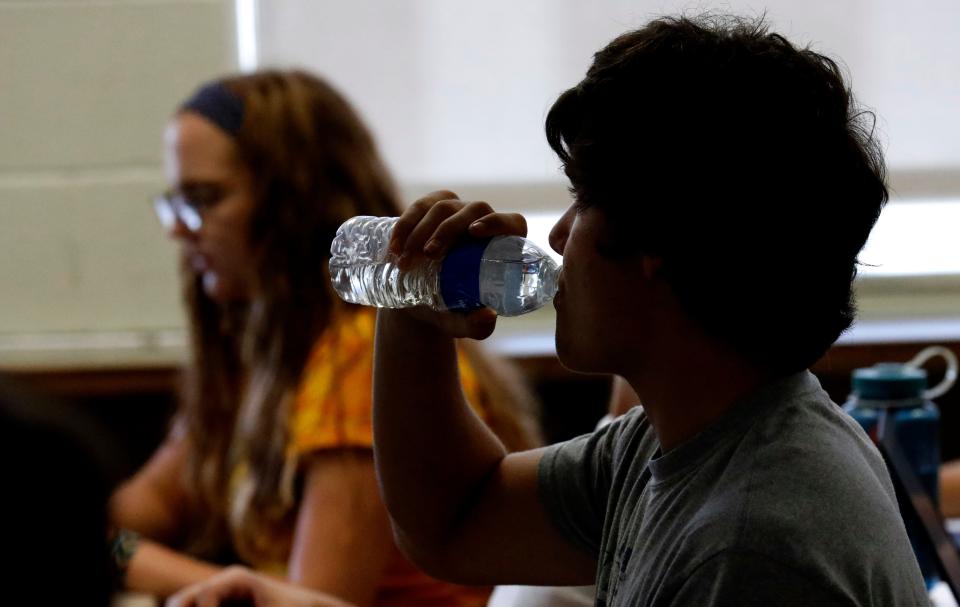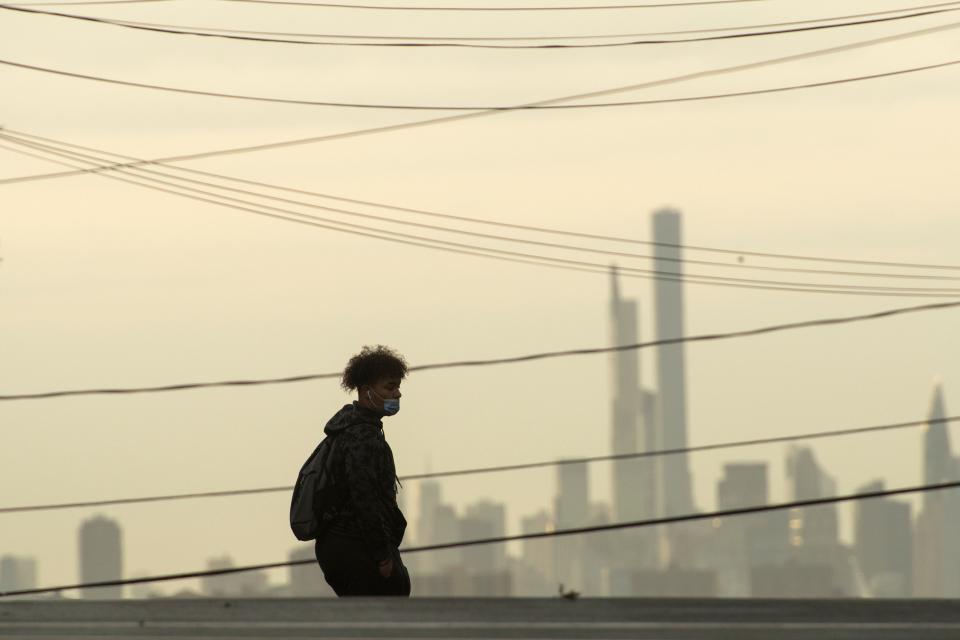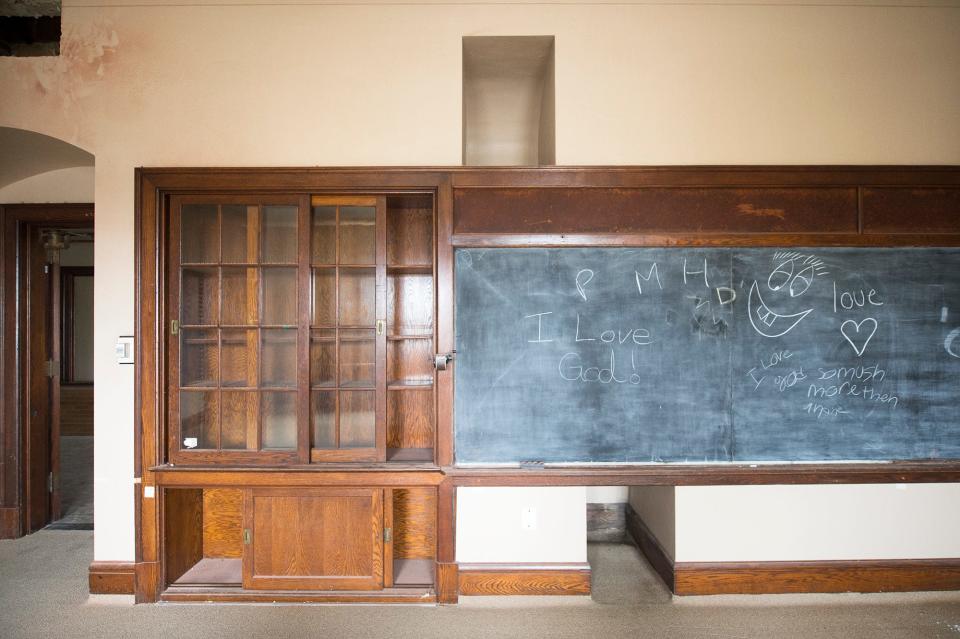Hotter temperatures a threat to students in schools with no air conditioning
Days into the school year, Amanda Turner and her students found the temperatures in her Baltimore classroom unbearable.
The heat that week reached into the 80s and 90s. The air was thick as humidity set in after recent rainfall, Turner said. And there, in a windowless storage room turned classroom, Turner's English as a Second Language students sat in a near "comatose" state, the teacher said.
The room didn't have air conditioning. The students, Turner said, were constantly fanning and wiping themselves.
"It was really hot," she said. "I took it slow and I retaught the information, but I don't think they were absorbing much, to be honest."
As climate change becomes a more significant part of our reality, experts say, the nation's schools must do something about hotter classrooms, especially those without working cooling systems. In recent weeks, overheated schools across the country have sent students home early or canceled school days to help protect children.

Some studies have shown students struggle to learn when it's too hot.
According to a 2018 study, PSAT test takers tackling the exam during warm days experience reduced learning, "with extreme heat being particularly damaging."
A 2015 study out of the University of Tulsa looked at data from 70 elementary schools in the Southwest and found fifth grade students' math scores increased with higher ventilation levels.
More school districts are in need of air conditioning today compared with schools in 1970, according to the Center for Climate Integrity, a nonprofit organization that works with communities to hold oil companies accountable for climate change.
And upgrading schools to control for extreme climate could cost already financially strapped districts millions of dollars or more in improvements, experts said.
Classrooms close because of high temperatures

Educators in California, Colorado, Pennsylvania and Ohio have closed classrooms early in recent weeks because of record temperatures.
Richard Wiles, president of the Center for Climate Integrity, said most school buildings were built more than a half century ago, when Northern and Midwestern climates tended to be cooler. At the same time, hotter parts of the country may not have needed as much air conditioning.
These days, many schools are not properly equipped to confront weather events brought on by climate change, Wiles said. Schools that can afford to upgrade do, he said. But many schools, including many low-income Black and brown school districts, don't get needed upgrades.
"These are the people who pay the price," he said. "They had absolutely nothing to do with causing the problem. And yet they're the ones who suffer the most because of it."
A study in 2021 from the Center for Climate Integrity found more than 13,700 K-12 public schools that didn't need cooling systems in 1970 will need them by 2025. New York City, the nation's largest school district, must spend up to $1 billion in ventilation system costs by 2025 because of climate change.
Students struggle to focus in too-hot classrooms
School closures because of sweltering temperatures aren't new, but they are becoming more common, educators said.
In May, Detroit shut down classrooms because of high temperatures, news outlets reported. School officials made the same decision in June 2018, closing schools early for three consecutive days.
About 80% of schools in the Detroit public school system don't have air conditioning. The school district and union leaders said that reality can make learning a challenge.
"On high temperature days, without AC, hot classrooms and schools can lead to students to be generally irritable and distracted. This leads to students not being able to focus on learning, which can lead to behavior issues," said Chrystal Wilson, assistant superintendent of communications.
The district said it aims to put air conditioning in 95% of its schools within the next five years.
Lakia Wilson, executive vice president of the Detroit Federation of Teachers, a labor union, said students shouldn't be exposed to dangerous weather conditions while trying to get an education.
"Students are focusing on 'How do I get relief from being so hot?' They're in uniform. They don't have on tank tops," she said.
In Chicago, air conditioning isn't always a priority as some schools deal with a lack of space and other student safety concerns, said Lauren Bianchi, a teacher at George Washington High School. But it's still a top concern, she said.
And when a classroom is too hot or cold, she said, the students just “shut down” and put their heads down.
“This biggest thing is just inconsistency. A lot of our schools, including Washington High School where I’m at, part of the building could be freezing, part of the building could be 80-plus degrees,” Bianchi said.
Former Mayor Rahm Emanuel promised in 2016 that all city public schools would have air conditioning.
"Air conditioning is required for every classroom and is considered a requirement for a healthy learning environment," the school district said in a statement to USA TODAY.
All active classrooms throughout the district have had window units or central air since 2016, school officials said. Underutilized schools may not have air conditioning in every room, but all used spaces have cooling systems.
Schools need money for air conditioners
Andy Pallotta, president of the New York State United Teachers union, said he's encouraging schools to devote more spending to address higher temperatures, but he understands schools might have other priorities, such as campus security and lead piping.
New York requires schools to provide heat when classrooms get too cold or after a certain date. The union wants similar considerations to cool schools when temperatures climb above 80 degrees.
"It's just really not acceptable anymore in our society that we would have the schools hot, and yet you can go to a department store and would never, never accept that," he said.
In Yonkers, a city of about 200,000 outside New York City, teachers shuttle students in and out of the air-conditioned school libraries when the heat becomes unbearable.
Samantha Rosado-Ciriello, president of the Yonkers Federation of Teachers, a labor union, said one air-conditioned area is not enough to overcome heat in many other parts of the school. In recent years, she said, the district has seen people faint or go to the hospital because of heat.
She said teachers try to make do, sometimes bringing in their own air conditioner.
"Imagine being in a closed room surrounded by cinderblock walls. That's what our schools are," she said. "That's a pizza brick oven."
Yonkers Public Schools Superintendent Edwin Quezada said schools' outdated infrastructure is to blame. Out of the district's dozens of buildings, he said about 50% need to be replaced.
"This is about a complete overhaul of the schools' infrastructure in Yonkers and America," he said. "The affluent communities can't be the only ones in our country that have access to air conditioning and beautiful schools."

Parents worry for their children
Parents said they are frustrated their children are being exposed to extreme heat at school.
Lately, Katidia Haro's youngest daughter has been complaining that the air conditioning in her Los Angeles school is not strong enough to combat the heat.
Haro requested that her daughter be seated closer to the cooling vents, but that doesn't help the other students. What's more, the sizzling temperatures mean the water fountain spurts out scorching water. The school also doesn't have enough tree canopy to help make playing outside cooler during warmer months, Haro said.
When asked for comment, officials at the Los Angeles Unified School District sent a news release that said they will continue to prioritize replacing heating and air condition systems.
Haro, an advocate with Reclaim Our Schools LA, a social justice coalition focused on improving local schools, said a clear class divide has emerged as higher-income areas provide more green solutions for their students while others, especially people in low-income Black and Hispanic communities, are seeing no change.
“This is just part of a larger systemic issue where our communities (of color) suffer on so many levels," she said.
This month, as California cities hit record-high temperatures, the air conditioning in teacher Lauren Hussey's classroom in Los Angeles failed.
The campus doesn't always feel safe for students. When it gets too hot to have lunch outdoors because the school lacks shade, students find a way back to her classroom.
“I worry about their safety and well-being,” she said.
Back in Baltimore, teacher Wyatt Oroke said parents are weighing whether they should send their children to an uncomfortable classroom for a few hours or keep them at home.
"It really created a burden on our families and on the community to have to step up day after day as we continue to deal with heat and infrastructure that is outdated," Oroke said.
Oroke, Maryland's teacher of the year in 2021, has air conditioning in his classroom, but that's not the case in hallways and auditoriums.
A new school is being built and should be ready in three to five years. Until then, his students will continue to be hot on some days.
Officials with Baltimore City Public Schools said in a statement that extreme weather can limit learning gains, but they said they are launching tutoring programs to help offset learning loss.
"They grab their lunch from the cafeteria but don't eat down there because it's too hot," he said. "We don't use the auditorium. We can't really use the gym."
Tiffany Cusaac-Smith covers race and history for USA TODAY. Click here for her latest stories. Follow her on Twitter @T_Cusaac.
This article originally appeared on USA TODAY: Are schools ready for climate change? Students could suffer with no AC

